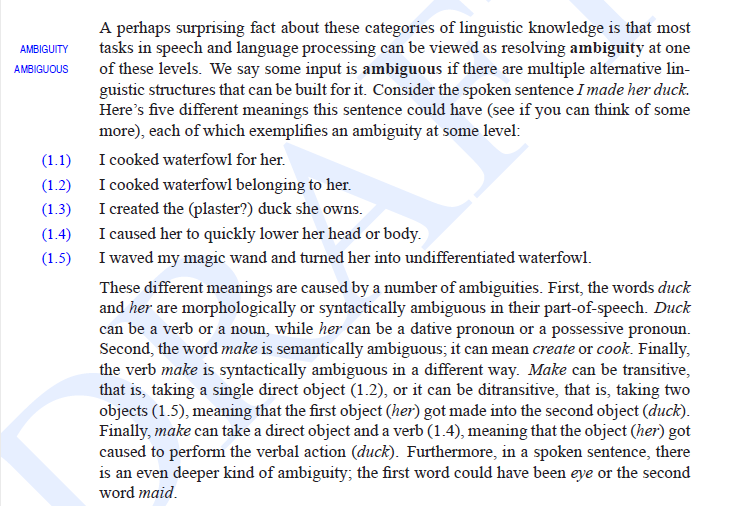Question
1. Explain what each of the 5 different interpretations of the sentence I made her duck means using your own word(s) (not the words in

1. Explain what each of the 5 different interpretations of the sentence I made her duck means using your own word(s) (not the words in the book, or not just the words in the book). For example, duck can mean a kind of bird (as a noun) or waterfowl as the authors used (in this interpretation, duck is canard in French), but this word can also be a verb. In this question, you are explaining what is (1.1), what is (1.2), etc. of the 5 interpretations of I made her duck.
2. Using semantics (multiple meanings of the same word), grammar such as parts of speech (duck can be a noun or a verb for example), analyze the sentence I made her duck. In this question, you want to explain why there is the interpretation (1.1), why there is (1.2) etc.
3. In the book Artificial Intelligence, A modern approach, third edition by Stewart Russel and Peter Norvig, they showed a sentence Fall leaves fall and spring leaves spring that is ambiguous. Here fall can be a noun or a verb, so is leaves and spring. Find at least two different interpretations of this sentence (or explain that there is only one way to interpret this sentence).
4. Find example(s) in other language(s) where ambiguity happens. The language can be Spanish, German, Farsi, Tamil, Mandarin, etc.
A perhaps surprising fact about these categories of linguistic knowledge is that most AMBIGUITY tasks in speech and language processing can be viewed as resolving ambiguity at one AMBIGUOUS of these levels. We say some input is ambiguous if there are multiple alternative lin guistic structures that can be built for it. Consider the spoken sentence Imade her duck. Here's five different meanings this sentence could have (see if you can think of some more), each of which exemplifies an ambiguity at some level (1.1) Icooked waterfowl for her (1.2) I cooked waterfowl belonging to her (1.3) I created the (plaster?) duck she owns. (1.4) I caused her to quickly lower her head or body. (1.5) I waved my magic wand and turned her into undifferentiated waterfowl. These different meanings are caused by a number of ambiguities. First, the words duck and her are morphologically or syntactically ambiguous in their part-of-speech. Duck can be a verb or a noun, while her can be a dative pronoun or a possessive pronoun. Second, the word make is semantically ambiguous; it can mean create or cook. Finally, the verb make is syntactically ambiguous in a different way. Make can be transitive, that is, taking a single direct object (1.2), or it can be ditransitive, that is, taking two objects (1.5), meaning that the first object (her) got made into the second object (duck) Finally, make can take a direct object and a verb (1.4), meaning that the object (her) got caused to perform the verbal action (duck). Furthermore, in a spoken sentence, there is an even deeper kind of ambiguity; the first word could have been eye or the second word maid
Step by Step Solution
There are 3 Steps involved in it
Step: 1

Get Instant Access to Expert-Tailored Solutions
See step-by-step solutions with expert insights and AI powered tools for academic success
Step: 2

Step: 3

Ace Your Homework with AI
Get the answers you need in no time with our AI-driven, step-by-step assistance
Get Started


